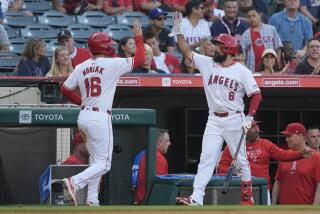Why the Angels chose a catcher in decline to lead their pitching staff
- Share via
Reporting from Tempe, Ariz. — A free-agent candidate to fill the Angels’ vacancy at catcher clicked off a conference call in December, and within minutes team officials knew they’d found their man.
It did not matter to them that information about the catcher’s defensive skills presented a negative case. It did not matter to them that his offensive production had slipped steadily for two consecutive seasons.
What mattered most, Jonathan Lucroy possessed in abundance. Once considered an elite receiver behind the plate, he had experience and knowledge of the game, two things the Angels lacked on their 40-man roster at the time.
He was not a Gold Glove winner, like former Angels backstop Martin Maldonado, but Lucroy was open to learning new skills. He wanted to adapt.
So about 10 days after the phone call, general manager Billy Eppler agreed to sign Lucroy, 32, to a one-year, $3.35-million deal.
In the two weeks he has now spent around the Angels at Tempe Diablo Stadium during spring training, Lucroy has already made strides toward proving himself worthy of the investment.
“His presence is emerging already around the club, and we haven’t even played a game,” Eppler said Friday, hours after the Angels’ final practice before the start of Cactus League play was moved indoors because of rain.
Lucroy’s defensive decline the last four years is chronicled by Baseball Prospectus’ statistics on framing pitches. Lucroy went from leading baseball with 31.5 runs saved from pitch-framing in 2014 to losing a league-worst 17.9 runs from framing in 2017. His called-strike rate dipped so far below average he ranked 27th out of 40 catchers who accumulated at least 3,500 framing chances last year — and Lucroy used to be one of the best in baseball when it came to getting calls on borderline pitches in the lower third of the strike zone.
The precipitous drop-off in defense didn’t seem to mesh with the Angels’ relatively inexperienced pitching staff. They had pursued more defensively sound options during the offseason in Wilson Ramos, who signed with the New York Mets, and former Dodger Yasmani Grandal, who went to the Milwaukee Brewers.
But in that December chat, Lucroy expressed a keen desire to improve the advanced catching metrics that had over time been downgraded by analysts. All he needed was a place where he could rediscover his previous form.
The Angels offered a perfect environment for Lucroy to thrive. Their new coaching staff was again stocked with catchers, from manager Brad Ausmus to bench coach Josh Paul and catching coach Jose Molina. The trio played a combined 24,587 innings and 42 years in the major leagues.
Sign up for our daily sports newsletter »
Ausmus and Molina, especially, were well regarded for their framing capabilities and had lengthy major league careers as a result. They can all share ideas with Lucroy, encouraging him to try different positions behind the plate or to employ new techniques to present umpires the best views on pitches.
“Just constantly try to work on different stuff, on bad habits he had and try to make it better,” Molina said. “I think we are in the right direction with that.”
Lucroy, who rebounded slightly in 2018 and lost 3.7 runs from framing while playing with the Oakland Athletics, expects to flourish with the dedicated assistance.
“That’s really all you can ask for in terms of a destination in free agency,” Lucroy said upon arriving for his first official workout with the Angels on Feb. 13. “A place that they want to bring you in, they value you and they want to make you better.”
The Angels, of course, don’t have to build Lucroy up from scratch. Quantitative analysis does not account for the years of expertise he accumulated with the Milwaukee Brewers, who saw their third-round pick of the 2007 draft become a two-time All-Star.
No statistic quantifies the work Lucroy did leading a cobbled-together Athletics pitching staff that, like the Angels’ own corps, was decimated by injuries in 2018. Despite all the turnover, Lucroy helped guide the group to a 3.81 earned-run average, low enough to rank 11th in baseball.
“That would be the holy grail in metrics if you could figure out how to put a number on guys who call good games or work with pitchers,” Ausmus said.
So even though the fancier numbers didn’t paint Lucroy as the Angels’ best option at catcher, he fit their club. The team expects his experience to make up for what he’s lost on the offensive side — there were already signs, like an improvement in how hard he hit balls last year, that led the Angels to believe he can return to All-Star form — and for his dedication to receiving as a craft to make up for the analytical slide.
“I don’t know how they calculate those but I feel like there’s gotta be some room for error,” said Trevor Cahill, who pitched for the Athletics last year and signed with the Angels before Lucroy. “Because I feel like he’s the same. He receives just as well as he did back when he was with Milwaukee. … As far as framing, he’s as good as I’ve had.”
Short hops
Shohei Ohtani, last year’s American League rookie of the year, hit off a tee for the first time since undergoing elbow ligament replacement surgery in October. He spent 15 minutes in the batting cages Friday, taking 20 swings off the tee and 35 dry swings. Ohtani, who will only hit for the Angels this season, had been limited only to dry swings during the first few weeks of camp.
More to Read
Go beyond the scoreboard
Get the latest on L.A.'s teams in the daily Sports Report newsletter.
You may occasionally receive promotional content from the Los Angeles Times.







